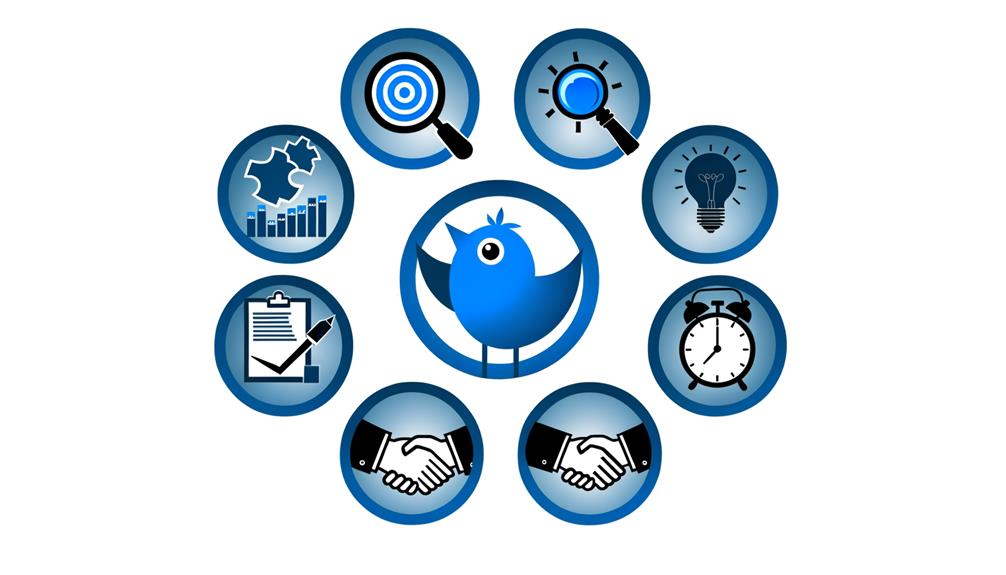No products in the cart.
As the saying goes, ‘The early bird catches the worm,’ and in the digital age, that worm could very well be your startup’s success on Twitter. You’ve got access to over 320 million monthly users, but tapping into that audience requires more than just showing up; it demands a strategy.
By setting clear advertising goals, crafting engaging content, and analyzing your campaign’s performance, you’re laying down the groundwork. But how do you ensure your efforts don’t just blend into the digital noise?
Stick around, and you’ll discover how to elevate your Twitter ad strategies from good to great, making every tweet count towards your startup’s growth.
Key Takeaways
- Use Twitter’s Lead Generation Cards to directly capture leads from your audience.
- Implement precise audience targeting to increase ad relevance and campaign performance.
- Develop creative content that highlights your unique value proposition and engages users.
- Monitor and adjust budgeting and bidding strategies based on performance analytics for cost-efficiency.
Setting Advertising Goals
To effectively leverage Twitter for your startup’s growth, it’s crucial to set clear advertising goals, such as boosting brand awareness, driving website traffic, or generating leads. Establishing these objectives at the outset allows for precise goal measurement and campaign tracking, ensuring you’re not just throwing darts in the dark but are strategically aiming to hit your target market’s bullseye.
Delving into audience research is your next critical step. By understanding the demographics, interests, and behaviors of your potential customers, you tailor your Twitter advertising to resonate with them deeply. This alignment between your campaign’s message and your audience’s needs amplifies the effectiveness of your efforts, particularly in lead generation.
Moreover, leveraging tools like Twitter’s Lead Generation Cards can significantly enhance your ability to capture leads. These cards enable users to express interest directly through your tweets, simplifying the sign-up process and thereby increasing your conversion rates. Tracking these interactions provides valuable insights, allowing you to refine your strategy continuously and achieve a higher return on investment.
Audience Targeting Techniques
You must accurately define demographic parameters to ensure your Twitter ads reach the right audience.
By leveraging interest targeting, you’ll tap into specific groups that are more likely to engage with your content.
This strategic approach enhances ad relevance and drives better campaign results.
Define Demographic Parameters
Identify and target your ideal audience by setting precise demographic parameters, leveraging Twitter’s extensive range of options to engage users most interested in your startup’s products or services. Utilizing detailed targeting criteria enables you to make data-driven decisions, ensuring your ads reach the right demographics for effective audience engagement. This approach not only sharpens your targeting strategies but also enhances the relevance of your messaging.
| Demographic | Targeting Option | Purpose |
|---|---|---|
| Age | Specific age ranges | Tailor content |
| Gender | Male/Female/Other | Customize messaging |
| Location | Countries/Cities | Localize advertisements |
| Interests | Keywords/Behaviors | Increase relevance |
| Device Usage | Mobile/Desktop | Optimize viewing experience |
Leverage Interest Targeting
Dive into interest targeting to precisely align your Twitter ads with users whose interests and behaviors match your startup’s offerings, thereby enhancing engagement and conversion rates. By leveraging interest segmentation, targeting becomes a powerful tool in your arsenal. This approach ensures that your ads reach individuals genuinely interested in what you’re offering, leading to higher quality interactions.
Consider the following to optimize your strategy:
- Utilize Twitter’s interest categories for precise audience targeting.
- Tailor ad content to echo the interests and preferences of your target audience.
- Monitor and adjust your strategies for continuous engagement optimization.
Interest targeting not only boosts the relevance of your ads but also contributes significantly to engagement enhancement. By focusing on users with a predisposed interest in related topics, you’re more likely to see an uptick in conversions, making it a cornerstone in your startup’s Twitter ad strategies.
Crafting Engaging Ad Copy
To elevate your Twitter ad campaigns, you must highlight your unique value proposition and adopt action-oriented language. This approach not only differentiates your offer but also motivates potential customers to act swiftly. Leveraging these strategies transforms your ad copy from mere text into a compelling call to engagement.
Emphasize Unique Value Proposition
Highlighting your startup’s unique value proposition in ad copy is crucial for standing out from competitors and captivating your target audience. Through value proposition differentiation, you underscore what makes your offering distinct. Engaging copywriting, anchored in storytelling, makes your message memorable. Adopting a problem-solving perspective shows how your product fills a crucial gap.
To craft ad copy that resonates:
- Identify the core problem your startup addresses, making it the centerpiece of your narrative.
- Showcase real-life applications of your solution to illustrate its impact.
- Leverage emotional storytelling to forge a deeper connection with your audience.
This strategic approach ensures your ad copy not only grabs attention but also speaks directly to the needs and desires of your target market, setting the stage for startup success.
Utilize Action-Oriented Language
After emphasizing your startup’s unique value proposition, it’s crucial to craft ad copy that compels action using action-oriented language. Integrating strong verbs like ‘act now,’ ‘buy today,’ or ‘sign up’ not only drives immediate engagement but is a cornerstone of conversion optimization.
By incorporating phrases that convey urgency, such as ‘limited time offer’ or ‘exclusive deal,’ you’re not just nudging; you’re compelling your audience towards swift action. This approach significantly boosts call to action effectiveness, translating into higher click-through rates and conversions.
Designing Impactful Ad Visuals
Crafting compelling ad visuals is crucial for capturing the attention of your target audience on Twitter. With 80% of users accessing the platform via mobile devices, your ad’s first impression must be powerful and immediate. Utilizing high-quality images or videos can boost engagement by up to 200%. This is where visual storytelling and creative design become your allies.
To ensure your visuals stand out:
- Incorporate clear branding elements for better brand recognition and recall. Your logo, color scheme, and any recurring motifs should be instantly recognizable.
- Use eye-catching colors, compelling graphics, and concise text to command attention within the bustling Twitter feed. Keep it simple yet striking.
- A/B test different visual formats to pinpoint what resonates best with your audience. This iterative approach allows you to refine your visuals based on real data.
Budgeting and Bidding Strategies
Understanding how to effectively manage your budget and optimize bidding strategies is crucial for maximizing the impact of your Twitter ads. You’ve got the power to control your ad spend with a choice between setting a daily or total budget. This ensures you’re never caught off-guard by unexpected expenses.
When it comes to bidding, you’re faced with two main paths: automatic bidding and manual bidding. Automatic bidding simplifies the process, letting Twitter’s algorithms seek out the best results within your budget. On the other hand, manual bidding hands you the reins, allowing for adjustments based on real-time performance analysis. This strategic flexibility is key for startups aiming to stretch every dollar.
Here’s a concise breakdown:
| Strategy | Pros | Cons |
|---|---|---|
| Automatic Bidding | Simplifies campaign management | Less control over individual bids |
| Manual Bidding | Greater control over bid optimization | Requires constant performance tracking |
| Bid Modifiers | Enables targeted bid adjustments | Complexity in setup and management |
Monitoring and adjusting your strategies based on bid optimization and budget allocation are essential steps. They ensure you’re not just spending efficiently, but also capitalizing on opportunities for better ROI through performance analysis.
Analyzing Campaign Performance
To effectively gauge your Twitter ad campaign’s success, it’s crucial to analyze key performance indicators (KPIs) like engagement rate and conversion rate. Delving into these metrics not only offers a snapshot of your campaign’s current performance but also provides actionable insights for future strategies.
Performance evaluation hinges on a comprehensive understanding of data insights. By meticulously tracking metrics such as reach, impressions, click-through rate (CTR), and conversion rate, you’re equipped to decode the narrative behind each number. Engagement analysis and trend tracking further enrich this narrative, enabling you to pinpoint what resonates with your audience and why.
Consider these pivotal aspects:
- Audience Growth Trends: Monitoring follower growth and hashtag engagement levels highlights whether your content is attracting and retaining interest.
- Tweet Performance: Evaluating retweets, likes, and shares offers direct feedback on your content’s impact and engagement.
- Conversion Rates and Lead Generation: These metrics are vital for assessing the direct business impact of your campaigns, guiding you toward more profitable endeavors.
Ad Optimization for ROI
After analyzing your campaign’s performance, it’s essential to focus on ad optimization strategies to maximize your return on investment (ROI). By refining your ad creative and honing in on lead generation, you’re setting the stage for unprecedented growth.
Start by utilizing lead generation cards on Twitter. These cards are a game-changer, potentially boosting your ROI by up to 15%. They’re straightforward yet effective in capturing leads directly from your tweets.
Don’t overlook the power of personalization either. Responding to retweets with personalized thank you messages can significantly drive more leads and email sign-ups. It’s a simple gesture that resonates well with your audience, fostering a sense of community and engagement.
Consider leveraging Twitter’s event targeting to achieve up to 11% increase in ROI. This strategy allows you to reach individuals engaging with event-related tweets, providing a ripe audience for your ad creative. Similarly, targeting business behavior audiences—focusing on specific company sizes, industries, and occupations—can yield a ROI boost of up to 7%.
Lastly, implement hashtag list building and targeting strategies. By focusing on custom audiences based on chosen hashtags, you can see a ROI increase of up to 12%. This approach ensures your ad creative reaches those most interested in your message, optimizing your lead generation efforts for maximum impact.
Frequently Asked Questions
What Makes a Successful Twitter Ad?
A successful Twitter ad captivates with visual appeal, directly speaks to target demographics, and prompts action. By analyzing performance, you’ll fine-tune your strategy, ensuring your content resonates and innovatively meets your audience’s needs.
What Is the Best Marketing Strategy on Twitter?
The best marketing strategy on Twitter combines influencer partnerships to extend reach and content designed for virality to engage users deeply. This approach leverages Twitter’s strengths, maximizing engagement and driving innovative campaign success.
What Ads Perform Best on Twitter?
Ads with videos lead in engagement on Twitter, significantly boosting retweets. Partnering with influencers can amplify this effect, as their endorsements bring credibility and wider reach, making these strategies pivotal for innovative engagement growth.
How Do I Optimize My Twitter Ads?
To optimize your Twitter ads, focus on audience targeting by leveraging relevant keywords and hashtags. Incorporate creative visuals and concise messaging to boost engagement. Analyze metrics for data-driven adjustments and experiment with various ad formats.
Conclusion
In conclusion, to catapult your startup to success on Twitter, you’ve got to:
- Set precise goals
- Target your audience smartly
- Craft engaging ad copy
- Design visuals that make an impact
Don’t forget to budget wisely and bid strategically. Always analyze your campaign’s performance and optimize for the best ROI. By following these strategies, you’re not just spending on ads; you’re investing in your startup’s growth.
Stay focused, adapt, and watch your business thrive.






